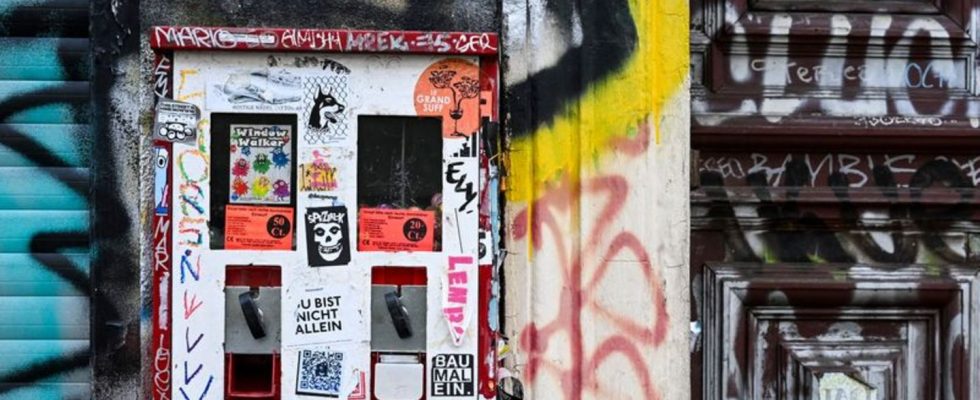consumption
Why gumball machines are so nostalgic
They still exist – even if the gumball machines are often pasted over or sprayed on. photo
© Jens Kalaene/dpa
The chewing gum machines in cities are past their prime. Nevertheless, many people remember their childhood with the rusty and now often sprayed devices.
Chewing gum with strawberry flavor, in the shape of a watermelon or as “spooky eyes” – all available for 20 cents from small and rather inconspicuous machines. If you walk attentively through the streets, you will sometimes still see them: chewing gum machines on house walls, often hanging very low, pasted or sprayed, mostly red.
Although the vending machines are now significantly less popular than they were about 50 years ago, they still have a following. What makes the gumball machine so special – even today?
memories and anecdotes
Karin Falkenberg thinks it is so special in Nuremberg that she brought it to the Toy Museum for an exhibition last year. Because in addition to sweets, small rings, pins or rubber animals also come out of the shafts. “They are nostalgic objects,” says the head of the toy museum, who had started the project for the exhibition before the corona pandemic. Toys were on display between July and October vending machines over different years.
According to Falkenberg, toys and chewing gum were sold in one chute up until the 1970s. Then the food laws would have changed, since then the products in the machines have been issued separately. “A large number of personal memories are entwined around chewing gum machines, as we found in our exhibition. There wasn’t a single tour that didn’t tell at least four or five anecdotes,” explains Falkenberg, who is also director of the Institute for Ludology (game sciences). at the University of Applied Sciences in Berlin.
part of children’s and youth culture
From her point of view, strong childhood memories still make up the nostalgia of many people today. Children and young adults between the 1950s and the beginning of the 1990s made their first purchases at the machines. In contrast to the kiosk or supermarket, you didn’t have to talk to adults to buy sweets or toys, you could simply insert a coin. The gumball machine is an essential part of children’s and youth culture.
“In the 1950s, 1960s, 1970s and 1980s, he had all too unbelievable toy treasures in him, which in principle also represented the big world on a small scale,” says Falkenberg. For example lighters in miniature format, compasses, harmonicas or even tiny pocket knives. Rings in all possible designs were legendary – with little hearts, skulls, pictures of actors or artists such as Elvis Presley or luminous specimens from around the 2000s.
The rings are still popular in some cases, as Ralph Zimmermann, the first chairman of the Association of Vending Machine Specialists (Vafa), knows. The question has come up now and again as to whether one of these tin rings could be sent for an engagement. In another case, people wanted a specific bouncy ball from the past.
Little happiness
Ellen Markgraf is also enthusiastic about toys and slot machine culture. In 2022, the art historian published an illustrated book with chewing gum machines in Kassel. The photographer always has ten, 20 or 50 cents with her in a separate wallet so that she can buy something from the devices, she says. She also explains the childhood memories of many adults with the element of surprise. “You always had this moment of waiting: is it just chewing gum coming out or is there something else?”. For ten or 20 pfennigs you could get a little happiness.
According to Zimmermann, the machines are still in use, but the business is no longer as lucrative. Anyone who earns ten euros a month as an operator is already doing well. There are still between 300,000 and 400,000 gumball machines in Germany – between the 1950s and 1990s there were an estimated one million. “That will gradually become less and less,” says Zimmermann. This is mainly due to the fact that the cityscape is changing, old buildings are being demolished and rebuilt and fewer machines are being attached to new facades.
In many cities, however, old specimens are now being revived – instead of sweets, people can draw jokes, art or bee food, for example. Falkenberg thinks it’s a “sweet idea” to give new impetus to urban society. The expert believes that the fascination with chewing gum and toy machines will not disappear anytime soon. “As long as there are still children of the 50s, 60s and 70s, you will not lose lovers.”

